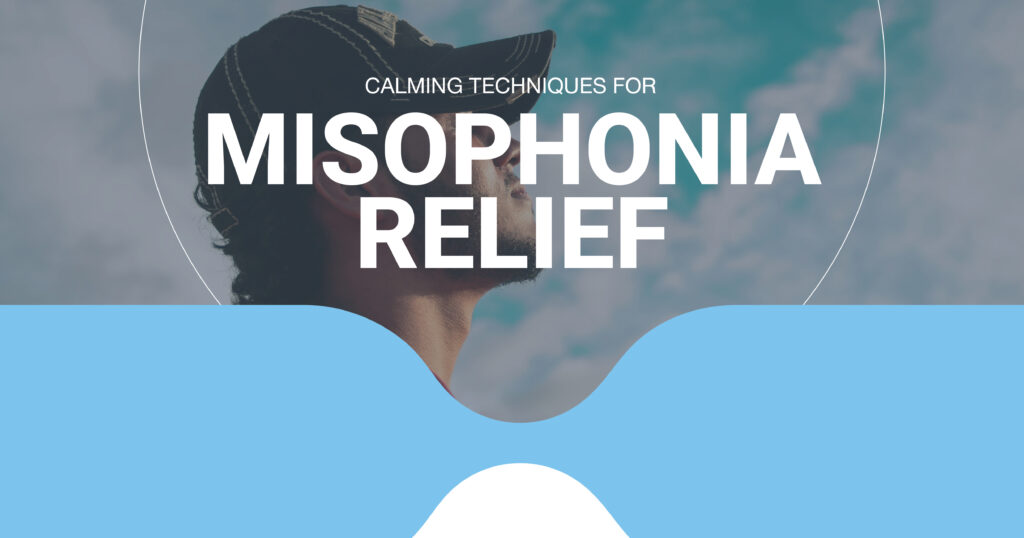You are sitting in a small cafe, and suddenly, you can hear someone chewing quietly, and it turns into a deafening thunderclap in your head. It needs a mere jolt, but it runs through your body, your shoulders get stiff, your pulse goes capering, your brain tries to think of a way out. These are actual experiences that happen repeatedly and are severely disturbing to Misophonic patients. But relief is possible.
With well-thought-out misophonia prescriptions, including therapy, sound policies, relaxation, and some lifestyle changes, you can start to reestablish serenity. This guide will show you how to do precisely that.
Understanding Misophonia and Its Impact on Daily Life
Misophonia is not an aversion to noise. It is a hyper-vigilance response to certain daily sounds, such as chewing, tapping, and rustling, that are so strong that they lead to emotional and body reactions.
These reactions may penetrate everyday life. A mute dinner is a battleground, and a common workplace turns out to be a minefield of clicking pens and crashing papers.
Once Misophonia comes into play, we live in an unpredictable and tiresome environment. Being aware that an otherwise harmless sound can trigger the fight-or-flight response, vast numbers of misophonic individuals live in anticipatory distress.
How Misophonia Affects Emotional and Physical Well-Being
Misophonia is emotional and physiological. On an emotional level, the response to triggers is frequently accompanied by irritation, anger, frustration, or even shame, particularly when the response does not seem commensurable with others.
Physically, it’s equally real. Individuals will complain of a higher heartbeat, muscle tension, sweating, and chest tightness, which are common to the body’s response to being triggered by the stress system.
It may add approaches to avoid triggers (sharing with friends, giving up activities, etc.), which may lead to anxiety, depression, and lower quality of life long-term. The acknowledgement of the full extent of the impact is the initial progress towards relief.
Cognitive Behavioral Therapy: Addressing Misophonia Triggers
CBT can be considered as one of the best evidence-based interventions in the arsenal of misophonia treatment. Concisely, CBT makes you identify the trigger-sound occasion, analyze your automatic thoughts (I can not deal with this, they are doing this on purpose), and thereafter deliberately change them to more adaptive ones.
CBT may include:
- Diagramming your emotional, physical, and behavioral reactions.
- Creation of coping scripts: other thoughts and reactions upon trigger hit.
- Developing the capacity to regulate emotions (to which we will refer later).
- Knowing how to re-tell the story: the sound occurs, your body responds, and you decide the next step to take as a whole.
Exposure Therapy Techniques for Misophonia Sufferers
Exposure Therapy is another top device. In regulated and non-threatening environments, exposure to the triggering sounds may be decreased with time, diminishing distress, however, in the case of misophonia, the studies are ongoing.
The common methods could involve:
- Beginning with soft forms of the trigger sound (e.g., distant chewing) in a safe setting.
- Combining the exposure with the relaxation or coping responses would allow the brain to remodel the automatic threat response.
- Progressively intensifying levels of coping strategy by gaining ground or reducing ground on the intensity or the levels of tactic.
Incorporating Relaxation Techniques for Emotional Regulation
You can hardly think of a quicker derailment when a trigger strikes you and the autonomic nervous system hijacks you, the heart races, the muscles tighten, and the mind races. This is where relaxation methods come in.
Deep diaphragmatic breathing, progressive muscle relaxation (PMR), guided imagery, and grounding exercises are some of the techniques that interrupt the chain reaction of sound – threat feeling – response – reaction.

For example:
- Deep inhalation: Breathe in and out for the four counts: 2 Hold, analyze 6.
- PMR: For 5 seconds, tighten all muscle masses (feet, calves, thighs, abdomen, arms, shoulders, neck), then relax. Feel the wave of release.
- Grounding or noticing: “What can I see? Hear? Touch? What is happening right now?”, shifting from the trigger-loop into present awareness.
- Visualization: Imagine a serene river, with each trigger sounding like a leaf floating downstream, notice it comes, let it pass.
Exploring the Connection Between Sound Therapy and Auditory Processing
We enter the field of auditory neuroscience and the intelligent utilization of sound here. Sound therapy, also known as background sound enrichment, is becoming famous in the field of misophonia treatment.
Idea: when the stimuli have an uncomfortable effect on you, you can play with neutral or even calming noises in your surroundings, which will lessen the intensity of the stimuli, giving you the fight. Examples include: white noise machines, nature sounds, ambient sound, and drop-in-the-ear sound. They can be used to conceal or dilute the trigger sounds to the backdrop and therefore lower their emotional impact.
Mindfulness Practices to Enhance Emotional Resilience
Mindfulness is mentioned within the category of sound-therapy, however, one may also take it to be included in the category of relaxation or emotional regulation. Mindfulness implies being completely mindful of what is being experienced, sound, thought, body response but without any judgement and instantaneous reactivity.
Some practices:
- Sound meditation: Spend 3 to 5 minutes of meditation in silence. Pay attention to the sounds in the environment. Perceive every sound as mere sound, no good or bad. When an occurrence occurs, say a chewing sound, note the body response, then redirect to breath or ambient sound.
- Carding meditation: scan awareness slowly all through the body, as in the feet, head, legs, torso, and arms.
- Anticipation: Notice tension as you imagine provoking. Relax in each zone.
- Mindful break: Suspend or bring to a stop when you perceive that you are beginning to be triggered or stressed. Breathe. Acknowledge: “I’m reacting.” Then choose: “What do I do next?” It is a little bit of a break that alters your path of reactions.
Lifestyle Changes and Support Strategies for Misophonia Relief
The cure does not merely comprise the therapy sessions themselves but is also spontaneous due to day-to-day routines, surroundings, and the support system you create around yourself. Take into account such lifestyle and support measures:
- Trigger mapping: Make a journal about your triggers: When, where, what sound, how you felt, how you acted. Patterns emerge.
- Modification of the environment: Soft furniture, carpets, curtains, noise absorbing material; sit-in a place in a public area where they are not known to have triggers; use ear friendly headphones where necessary.
- Messages and limits: Be frank to friends/family/co-workers: “This sound causes me, and I am practicing on it. When individuals learn, the stress layer in society is reduced.
- Support network: Find misophonic support groups (online forums), professionals well-defined on it. Feel seen. Know you’re not alone.
- Holistic habits: There should be more emphasis on sleeping, nutrition, movement, hydration, and stress management. A stressed body will increase the sensitivity of sound; a lower overall physiological load will decrease trigger reactivity.
Integrating Therapies for a Holistic Approach to Misophonia Management
The most effective strategies are created by combining therapy (such as CBT and exposure), effective strategies, mindfulness, and lifestyle changes. Keep in mind that it is a tapestry, each thread reinforces the entire.
Begin Your Healing Journey with Clear Mind Treatment
So now you have the what and how of calming methods to alleviate misophonia. In case you would like to receive personalized assistance, you can contact Clear Mind Treatment to get some advice. Their caring team is able to assist in creating an individualized plan that fits your path – connecting you with treatments, good instruments, meditation techniques, and blueprints of lifestyles that appeal to you. You do not need to drive this road by yourself.

FAQs
What role does sound therapy play in managing misophonia symptoms?
Sound therapy involves the use of neutral or soothing sounds (white noise, natural sounds, or ambient sound) in order to decrease the prevalence of trigger sounds in the soundscape. It acts to conceal or amalgamate trigger sounds to elicit reduced emotional and physiological response.
How can cognitive behavioral therapy help in addressing misophonia triggers?
CBT is used to begin to recognize your thoughts, feelings, and behaviors in relation to the triggers you give off, and to restructure them to create less automatic ways of responding and therefore be more under control.
What are effective exposure therapy techniques for individuals suffering from misophonia?
Some of the techniques involve slowly and harmlessly exposing yourself to less serious versions of what triggers you, combining the exposure with coping and other relaxation methods, and gradually increasing the intensity at a rate that you can tolerate. This has to be carried out under a controlled and supportive environment.
How do relaxation techniques aid in emotional regulation for those with misophonia?
To interfere with the fight-or-flight response, relaxation methods (such as deep breathing, progressive muscle relaxation, and grounding) are used. These methods lower levels of tension in the body, slow the pulse, and still the mind so that you have someone to choose whether to respond rather than withdraw.
What mindfulness practices can enhance emotional resilience in misophonia management?
The use of mindfulness methods (in the form of sound meditation, body scan, and mindful pauses) will condition you to attend to trigger sounds and your response to these sounds without viewing these actions as judgmental and escalated responses. Resilience is developed, and over time, you become less reactive and more deliberate in your response.





